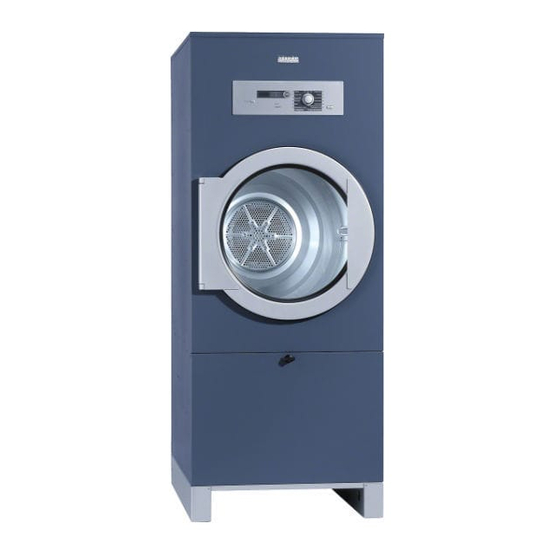Miele PT 8301 SL Інструкція з експлуатації Посібник з експлуатації - Сторінка 12
Переглянути онлайн або завантажити pdf Інструкція з експлуатації Посібник з експлуатації для Сушарка Miele PT 8301 SL. Miele PT 8301 SL 28 сторінок.
Також для Miele PT 8301 SL: Інструкція з експлуатації Посібник з експлуатації (44 сторінок), Коротка інструкція з експлуатації (2 сторінок)

Drying
Sort the laundry
Not all textiles are suitable for machine drying.
Please read the instructions given on the garment
care label.
The meaning of the care symbols:
q = Dry at normal temperature
r = Dry at low temperature
s = Do not tumble dry
Sort the laundry according to fibre type and weave to
ensure even drying and to prevent the risk of damage
to textiles.
,
To prevent the risk of fire, the following
must not be dried in this tumble dryer (with the
exception of those fabrics which can be dried in
the Special Programmes specifically designed for
them):
- fabrics which contain a large proportion of
rubber, foam rubber or rubber-like materials.
- items which have been treated with inflammable
cleaning agents.
- items which have been splashed with hair
lacquer, hair spray, nail varnish remover or similar
substances.
- items which have been soiled with oils or
residues containing grease (kitchen oils,
cosmetics etc.).
- items soiled with wax or other chemicals (e.g.
mops and floor cloths).
- items with damaged padding or fillings (e.g.
pillows, jackets).
- items soiled with grease or oil which have not
been properly cleaned beforehand. Use
heavy-duty detergents where necessary to clean
heavily soiled garments, e.g. workwear. If
necessary consult the detergent manufacturer for
advice.
The following textiles should not be machine
dried:
Woollens and wool blends as these tend to matt and
shrink. Partially dry these using the "Woollens"
programme.
Pure linen tends to roughen if tumble dried. Please
follow instructions given on the care label.
Important:
Textiles with large metal accessories such as
buckles, hooks and zip tags should be placed in a
laundry bag or a pillow case before drying. This is to
protect the drum from scratches and dents during
drying.
Garments with closed metal zips can cause the
sensor electrodes in the drum ribs to be bridged.
12
This can cause the drying process to go on for too
long, or to not finish at all. Open zips before drying.
Loopknit and woven textiles (e.g. T-shirts and
underwear) have a tendency to shrink depending on
their quality. This is made worse by over-drying. Do
not use "Cottons extra dry" for these textiles.
Starched laundry can be machine dried. Select the
most appropriate programme for ironing by hand or
machine.
Sort the laundry according to the level of dryness
required. It is not necessary to sort according to size.
Duvet covers and pillow cases should be closed to
prevent smaller items rolling up inside them.
For greater economy, dry a full load. Underloading is
uneconomical. Overloading will impair the drying
result and the laundry finish.
Rinsing the laundry using hot water in the final rinse
helps to reduce the residual moisture level, and the
residual heat in the laundry will help keep processing
time down, thus saving energy.
